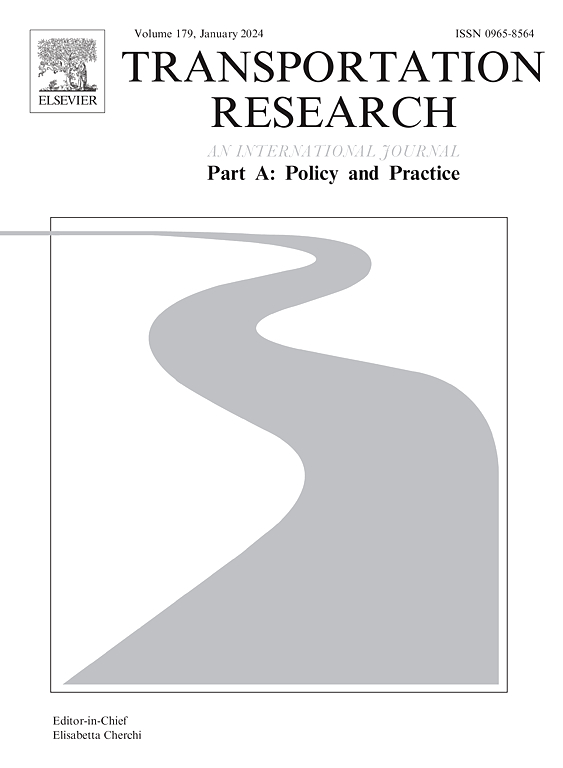Fleet sizing and static rebalancing strategies for shared E-scooters: A case study in Indianapolis, USA
IF 6.3
1区 工程技术
Q1 ECONOMICS
Transportation Research Part A-Policy and Practice
Pub Date : 2024-10-23
DOI:10.1016/j.tra.2024.104287
引用次数: 0
Abstract
With the rapid development of shared e-scooters, it is essential to understand their usage patterns for formulating informed e-scooter fleet management policies. This study first analyzes the usage pattern of shared e-scooters in Indianapolis, USA, by mining big e-scooter trip data. The analysis reveals an oversupply of shared e-scooters relative to actual user demand. Thus, a minimum fleet sizing algorithm is proposed to determine the required minimum e-scooter fleet size with the objective of reducing total operation cost, while ensuring demand coverage. Furthermore, three heuristic algorithms are proposed to address the static e-scooter rebalancing problem, focusing on minimizing rebalancing distance cost and rebalancing time. These algorithms consider practical operational constraints, including the number of rebalancing vehicles, their capacity, and the frequency of visits to e-scooter stations by rebalancing vehicles. The proposed algorithms are applied to e-scooter rebalancing scenarios with comparisons between the minimum and actual fleet sizes. The case study results in Indianapolis, USA demonstrate that the rebalancing distance cost with the minimum fleet size is significantly lower than that with the actual fleet size. What’s more, the rebalancing time can be reduced by about 12.34% to 27.80% when using the minimum fleet size. The findings of this study offer valuable policy implications and managerial insights for shared e-scooter operators and policymakers in developing effective e-scooter management strategies.
共享电动滑板车的车队规模和静态再平衡策略:美国印第安纳波利斯案例研究
随着共享电动滑板车的快速发展,了解其使用模式对于制定明智的电动滑板车车队管理政策至关重要。本研究首先通过挖掘电动滑板车出行大数据,分析了美国印第安纳波利斯市共享电动滑板车的使用模式。分析结果显示,相对于用户的实际需求,共享电动滑板车供过于求。因此,提出了一种最小车队规模算法,以确定所需的最小电动滑板车车队规模,目的是降低总运营成本,同时确保需求覆盖率。此外,还提出了三种启发式算法来解决静态电动滑板车再平衡问题,重点是最小化再平衡距离成本和再平衡时间。这些算法考虑了实际操作约束,包括再平衡车辆的数量、容量以及再平衡车辆访问电动滑板车站点的频率。建议的算法适用于电动滑板车再平衡场景,并对最小车队规模和实际车队规模进行了比较。美国印第安纳波利斯的案例研究结果表明,最小车队规模下的再平衡距离成本明显低于实际车队规模下的再平衡距离成本。此外,使用最小车队规模时,再平衡时间可减少约 12.34% 至 27.80%。本研究结果为共享电动车运营商和政策制定者制定有效的电动车管理策略提供了宝贵的政策启示和管理见解。
本文章由计算机程序翻译,如有差异,请以英文原文为准。
求助全文
约1分钟内获得全文
求助全文
来源期刊
CiteScore
13.20
自引率
7.80%
发文量
257
审稿时长
9.8 months
期刊介绍:
Transportation Research: Part A contains papers of general interest in all passenger and freight transportation modes: policy analysis, formulation and evaluation; planning; interaction with the political, socioeconomic and physical environment; design, management and evaluation of transportation systems. Topics are approached from any discipline or perspective: economics, engineering, sociology, psychology, etc. Case studies, survey and expository papers are included, as are articles which contribute to unification of the field, or to an understanding of the comparative aspects of different systems. Papers which assess the scope for technological innovation within a social or political framework are also published. The journal is international, and places equal emphasis on the problems of industrialized and non-industrialized regions.
Part A''s aims and scope are complementary to Transportation Research Part B: Methodological, Part C: Emerging Technologies and Part D: Transport and Environment. Part E: Logistics and Transportation Review. Part F: Traffic Psychology and Behaviour. The complete set forms the most cohesive and comprehensive reference of current research in transportation science.

 求助内容:
求助内容: 应助结果提醒方式:
应助结果提醒方式:


